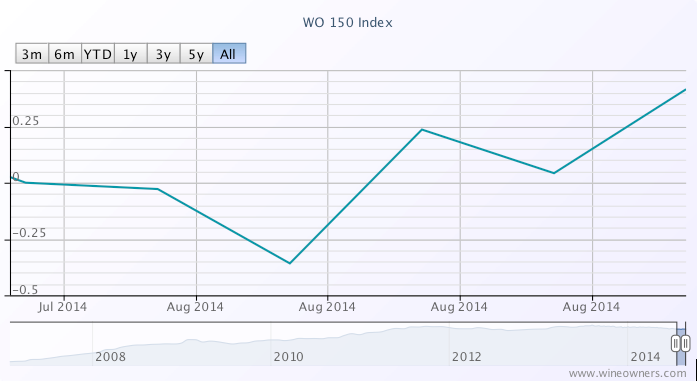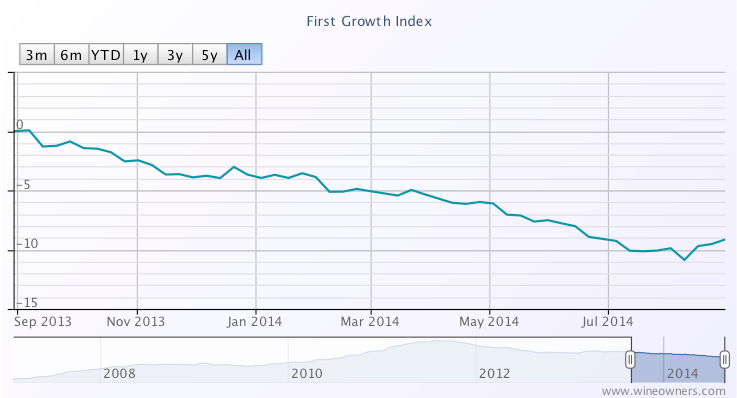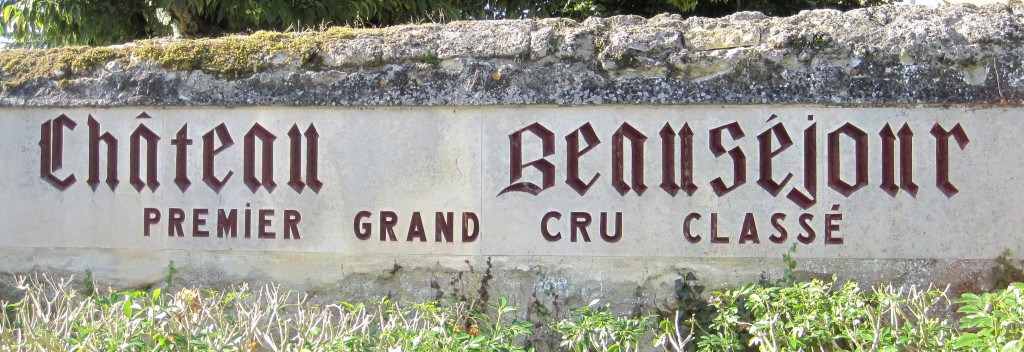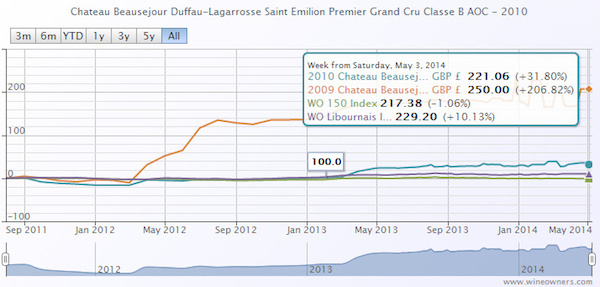by Wine Owners
Posted on 2014-09-12
With market sentiment for fine red Bordeaux brightening, we ask, what do the latest market numbers actually suggest?
Let's start with the market as a whole.
The Wine Owners 150 (WO 150) comprises investment grade wines across the top 40 performers of the last 20 years from all key regions of production. This index rose 0.4% in the last month compared with a fall of -4.45% over the course of the last 12 months. Of the most recent bottom 40 fallers, all were red Bordeaux. More positively there were 22 Bordeaux in the top 40 gainers.
1 month

1 year

The First Growths Index rose 0.98% over the last month, and is now down -9.14% over the last 12 months, off its early August lows of -10.87%
Haut Brion appears to be leading the charge, 1989 and 2006 showing strong double digit growth, with Mouton (1986, 1989, 1996, 1998 and 2010) showing 5%-8.5% growth along with Haut Brion 2003, Margaux 1986 and Lafite 1990. The predominance of older, scarcer vintages among the top movers is notable. Older vintages can show some of the sharpest short-term moves given there is much less of them in the market, so market movements in 25 year old vintages are not convincing bellwethers.
1 month

1 year

The Medoc classed growth index rose 0.23% over the month and was up 0.72% from its August lows, and is now down -4.8% over the last 12 months.
Palmer saw double digit growth in respect of vintages 2009 and 1998, along with Pontet Canet 1996, Leoville Barton 2006 and Gruaud Larose 2005. Risers however were largely offset by fallers across a broad range of vintages including 1996, 2000, 2005, 2006 and 2009. Although there is increasingly positive support for hard-hit wines from vintages such as 2005, the data does not yet substantiate an upturn.
1 month

1 year

The right bank also saw a rise comparable with the First Growths, with the Libournais Index up 1.09% over the last month, and up 2.5% from its August lows. It is now down just -0.98% over the course of the last year.
Top movers include Petrus 2010, Beausejour Duffau (1998 and 2010), VCC (2001 and 2010), Tertre Roteboeuf (2005, 2009, 2010), Belair [Monange] (2000, 2010), Latour a Pomerol 2005 and Pavie Macquin 2005.
1 Month

1 year

Green shoots?
It’s noticeable that merchants have been talking about restocking since July which can only be positive, but there are opposing views on where the latest data may lead the market.
With the exception of a 0.94 rise in the First Growths Index in December 2013, price declines have been inexorable since then – until now. The trade is split however on how much further First Growths have to fall, especially amongst the previously most inflated wines. With the First Growths down -27% since the peak in July 2011, a small rise of 0.98% may be positive but the inevitable continuing focus on value on the part of buyers favours the possibility of as many - or more - fallers vs risers over the remainder of 2014.
The Medoc classed growths saw a 0.7% uptick in March 2014 in addition to a rise last December in line with the First Growths. Taking all the data into account, it’s hard on that basis to read anything into the recent comparable bounce back from August lows.
The Libournais Index has performed the strongest over the last year with a 2.3% rise between mid January and mid February 2014, comparable with the performance over the last month after a summer of declines. Relative scarcity and a positive 3-year performance (+8%) suggest that the conditions for a broader based recovery are more firmly established for right bank fine wines.
Perhaps of significance, the 22 Bordeaux constituents showing price growth in the WO 150 index since the end of July compares with just 10 Bordeaux wines that have traded in positive territory on a 12 month view.
by Wine Owners
Posted on 2014-05-09

Beausejour Duffau is a great success story of recent years, especially if you are one of the buyers lucky enough to have secured an allocation of the 2009 (in particular) and 2010, both of which received price-boosting perfect ratings from Wine Advocate. The 2009, for example, which has been trading at £2850 has shown nothing but upside since release. The opening EP price here was £800, which is enough to deter the casual buyer, but those who fell in love with the wine from barrel samples have had their faith well rewarded by a market price of £3000, an increase of 270%, which is truly remarkable in an otherwise relatively stale market, and vastly outstrips the performance of pretty much anything else.
Buyers of the 2010 show an increase of around 30%, still very much bucking the trend, but slightly less favoured than the 2009, with an equivalent market price of £2652. Given the release price of the 2010, close to £2000 per case, buyers in that vintage were in a sense late to the party, the chateau having had the confidence to price quite aggressively in its second consecutive great vintage. The pricing performance here is probably also coloured by the fact that the 2009 was given a range of 96-98+ in initial tastings by Parker, while the 2010 was offered a marginally more confident 96-100, both being respectively upgraded and confirmed in a 100 point score.
Lucky owners of the 2009 are left in the enviable if awkward position of having to decide whether to take their £2000 per case profit now, or hold in anticipation of future increases (the last perfect score for Beausejour Duffau was 1990 which now trades at £7,500+ per case and has consistently risen since 2006).
There is always the option of laying it down for future drinking in the knowledge that it’s a 100 point wine for which they paid well below the odds on release. Given 2009 is in all likelihood a decade away from entering its maturity plateau, how many savvy buyers will be prepared to drink a case of wine that might be valued at £7,500-£10,000 by then?


